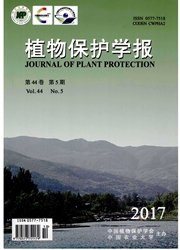

 中文摘要:
中文摘要:
大豆胞囊线虫Heterodera glycins Ichinohe病害是大豆生产中的毁灭性病害,对世界大豆生产造成重大损失。采用根染色法和常规土壤线虫分类鉴定技术研究了连作和轮作两种耕作方式下大豆胞囊线虫群体数量和土壤线虫群落结构的变化。结果表明,连作使大豆田土壤中胞囊和根系上各龄期胞囊线虫数量显著增加(95.6→335.5),而轮作积累很少(10.3→31.8),感病品种中J2的侵入数量决定了大豆胞囊线虫形成胞囊的数量(22.8→95.6,129.4→335.5)。玉米-玉米-大豆的轮作方式使胞囊积累最少(10.3)。轮作大豆田土壤线虫总数高于连作,主要由于轮作大豆田土壤线虫的优势属Helicotylenchus和优势营养类群植物寄生线虫PP的相对丰度高于连作,但大豆胞囊线虫的相对丰度正相反,连作(33.65%)高于轮作(0.91%),说明Heterodera glycines可以作为土壤线虫的关键属种用以指示土壤发病的严重程度。研究中重要的优势属和关键属种cp值均为3,说明其繁殖和抗干扰能力比较强。研究证明土壤线虫优势营养类群、优势属种和关键属种可以有效地指示农业土壤健康状况和大豆田的大豆胞囊线虫病害的发生程度。
 英文摘要:
英文摘要:
Soybean cyst nematode (SCN, Heterodera glycines) is a disastrous disease all over the world, which causing a lot of losses of soybean especially in USA, Canada and China. The number of SCN and soil nematode community structure were studied under continuous cropping and rotation soybean fields by root dying and traditional nematode classification in Wangjia, Shenyang City, Liaoning Province. The soil nematode community structure was surveyed and analysed using the mathematical statistics. The results would provide rightful tillage practices to control the soybean cyst nematode and other diseases of soybean, to keep the yield increasing sustainably in the northeast of China. The results showed that the number of SCN including the number of cysts and all juveniles of different stages in soil and roots of soybean was notably increased under continuous cropping soybean field against under rotation (95.6 in 2005 and 335.5 in 2006 vs. 10.3 and 31.8). The number of cysts in susceptible soybean was decided by the number of invaded J2, and it was the least under maize-maize-soybean rotation in the research. Total number of soil nematodes was much more in rotation than continuous cropping soybean field, because the relative aboundance of dominant genus Helicotylenchus which cp-scaling 3 and dominant tropic groups as plant parasitic feeders were higher in rotation than continuous cropping, but Heterodera glycines which cp-scaling 3 was more in continuous cropping than rotation. So H. glycines among of all kind of nematodes would be acted as key species that indicated the different degrees of SCN disease. Moreover dominant tropic groups and dominant genus would be more effective indicator to respond to soil health in soybean field in the northeast of China.
 同期刊论文项目
同期刊论文项目
 同项目期刊论文
同项目期刊论文
 期刊信息
期刊信息
